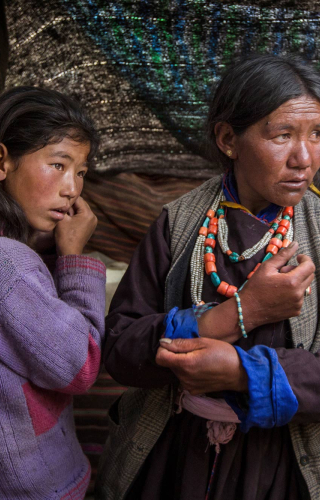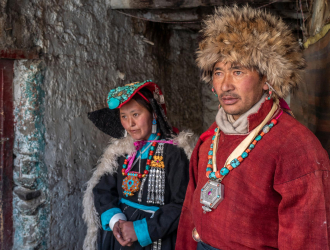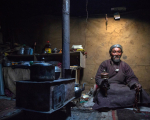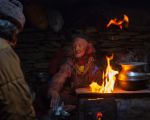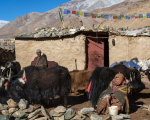As January dawns with the promise of a new adventure, I brave the freezing winter temperatures and head towards Leh, the district capital of Ladakh. From Leh, I hire a taxi and a guide and proceed further east. My destination is the Rupshu plateau, located at 4,500–5,500 metres above sea level on the Indo-Tibetan border. Rupshu is home to the Changpa nomads, who live here throughout the year, enduring sub-frigid winters with temperatures dropping 40 degrees below the freezing point.
The Changpas of Ladakh are a small and detached population of the Changpa people living in western Tibet. In colonial times, they migrated freely across the Himalayas with their livestock, but things changed after Indian independence in 1947 and China’s annexation of Tibet in 1950. The Indo-Chinese war of 1962 further hardened relations between the two neighbouring countries. International boundaries cut across migration routes and old trade routes closed permanently. Since then, the Changpas have made Rupshu in eastern Ladakh their permanent home, grazing their livestock in the Changthang Wildlife Sanctuary around high-altitude lakes such as Tso Moriri, Pangong Tso and Tso Kar.
As we leave Leh and the Indus Valley behind us, we find ourselves in a semi-arid mountainous region, clad with thick snow and frozen rivers. The road winds its way higher through an increasingly barren landscape and after five hours we reach Phobrang, one of the last Indian villages on the Tibet border. The villagers greet me with warm hospitality and broad smiles and make me feel at home in this climatically hostile environment. The winters are particularly severe on the Changpas and few outsiders visit them during this period. I am invited into their canvas rebo (tent). While chatting with the locals, they reveal that canvas tents are drastically replacing the warm yak-hair tents which are an integral part of their culture. Besides being warmer and waterproof, the yak-hair rebo is eco-friendly, unlike its synthetic replacements, and its extinction would severely affect the health and lifestyle of the Changpas.
Rupshu is a cold desert, bordered by snow-covered peaks and azure skies. Very little flora, other than grass, can grow in this inhospitable terrain. The only source of livelihood for the Changpas is nomadic pastoralism. They move around with large flocks of domesticated animals such as sheep, goat and yak. Besides, they also rear ponies for their transport and train sheepdogs to protect the livestock. These animals are all native to the region and are well adapted to survive in the extreme climate and thin atmosphere. The sheep and goats produce wool which is harvested by the Changpas. The wool grows thick during the long winter months; the colder the winter, the thicker is the woolly growth. This raw material is their main source of income in addition to trade in dairy products such as butter, milk and cheese.
I was disappointed to miss the harvesting of the priceless pashmina wool which takes place in mid-May, as summer hits the hills. Unlike sheep shearing in countries such as Australia and New Zealand, the Changpas do not cut off the entire fleece but use a comb to separate the delicate undercoat from the coarse main wool. The sheep cannot survive the frigid night temperatures, even in summer months, without their protective coating. The undercoat is very fine and soft, with a thickness between 12–15 microns. In addition to sheep wool, the Changpas also harvest yak wool, which is much thicker and coarser, thus unsuitable for weaving garments. Instead, it is woven into peraks (a type of headgear worn by married women), slings, ropes, blankets and yak-hair tents (rebo).
The fine undercoat is cleaned to separate it from coarser wool and to remove impurities and odour. The wool is then carded, hand teased and spun into yarn using a spindle. Nowadays, the Changpa spinners spin the yarns on their own with a spinning wheel, which is a departure from the time when the yarn was sold to middlemen from Leh, who bartered in barley and other material goods. The middlemen, in turn, sold the wool in the Kashmir Valley, where generations of expert weavers created beautiful pashmina shawls. The pashmina shawls, known as Cashmere, after Kashmir where they were produced, were noted for their softness and lightness and became extremely popular among the upper class in colonial India.
Unfortunately, Changpas benefited little by supplying the valuable raw material. Even now, a kilo of the raw material sells for only Rs 8,000. They were at a disadvantage because the women in their community did not have weaving skills of their counterparts in Srinagar. It is only in very recent years that some efforts have been made to encourage Changpa women to weave their pashmina products and sell them directly to tourists in Leh.
The core philosophy of nomadism is based on ideals of self-reliance and independence. These values have faced challenges ever since Ladakh was opened up for tourism in the 1970s. The tourism boom has affected Changpas in many ways. Because in the past they lacked education, Changpas had no social mobility and could not access government schemes or jobs. Modern-day Changpas send their children to study at boarding schools in Leh. This has empowered them as a community but has also altered traditional living, as educated Changpas now prefer to work in urban cities rather than live a hard life as a nomad. Living in Leh has also exposed a new generation of the people to the modern world and helped them learn new skills. When young Changpas return to their camps during the two-month-long winter vacations, they bring home stories of modern city life.
Change is, after all, inevitable in a globalised world. However, as a witness I cannot help but wonder: Will the traditional life and culture of the Changpas survive the ravages of time and modernisation? Will they be equal stakeholders in the development of Ladakh and get a reasonable income to continue with their priceless skill of producing cashmere? Many Changpa families have now sold off their ponies and replaced them with pickup trucks and SUVs for transportation. Changpa lifestyle has also changed due to global warming. Earlier, the nomads crossed Pangong Tso (‘tso’ means high grassland lake in Tibetan) for their winter pastures after the Ladakhi New Year and returned by riding over the frozen lake. Elders would make sure the ice was at least one arm thick so that the community could safely cross with their yaks. Now with thinner ice and fewer nomad families, this ritual is facing extinction. Inevitably, climate change has affected the pashmina production as well, both in terms of quantity and quality. Changpas have had to make peace with the changing winters and its direct impact on the standard of wool produced, as warmer winters produce less yield and thinner wool.
After living with them for 10 days, I bid a teary farewell to my warm Changpa brethren and head back to Leh. I spend some time in Leh to witness how the young Changpas who study there participate in ice hockey in the winter months. They practise on a temporary rink at Karzoo which is a frozen irrigation pond. Both men and women participate in matches and come here for training in the hope to be selected for the national teams.
As an outsider, it seems to me that time is running out for the Changpas, just like it ran out on my stay with the Changpas. Perhaps, I will return someday to do another story on them.
